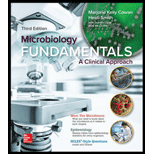
Microbiology Fundamentals: A Clinical Approach
3rd Edition
ISBN: 9781259709227
Author: Marjorie Kelly Cowan Professor, Heidi Smith
Publisher: McGraw-Hill Education
expand_more
expand_more
format_list_bulleted
Concept explainers
Textbook Question
Chapter 1.3, Problem 14AYP
Differentiate among primary, secondary, tertiary, and quaternary levels of protein structure.
Expert Solution & Answer
Want to see the full answer?
Check out a sample textbook solution
Students have asked these similar questions
Differentiate among primary, secondary, tertiary, and quaternary levelsof protein structure.
Distinguish among primary, secondary, tertiary, and quaternary protein structure
Distinguish among primary, secondary, tertiary, andquaternary levels of protein structure.
Chapter 1 Solutions
Microbiology Fundamentals: A Clinical Approach
Ch. 1.1 - List the various types of microorganisms that can...Ch. 1.1 - Describe the role and impact of microbes on the...Ch. 1.1 - Explain the theory of evolution and why it is...Ch. 1.1 - Explain the ways that humans manipulate organisms...Ch. 1.1 - Summarize the relative burden of human disease...Ch. 1.1 - Differentiate among bacteria, archaea, and...Ch. 1.1 - Identify an acellular infectious agent that is...Ch. 1.1 - Compare and contrast the relative sizes of the...Ch. 1.1 - Q.Can you think of a logical reason that a microbe...Ch. 1.1 - NCLEX PREP 1. For which of the following disease...
Ch. 1.2 - Make a time line of the development of...Ch. 1.2 - List some recent microbiology discoveries of great...Ch. 1.2 - Identify the important features of the scientific...Ch. 1.3 - Name the four main families of biochemicals.Ch. 1.3 - Provide examples of cell components made from each...Ch. 1.3 - Differentiate among primary, secondary, tertiary,...Ch. 1.3 - List the three components of a nucleotide.Ch. 1.3 - Name the three nitrogen bases of DNA and RNA.Ch. 1.3 - Prob. 17AYPCh. 1.3 - Recall three characteristics common to all cells.Ch. 1.3 - Q. Use context in the paragraph above to deduce...Ch. 1.3 - Prob. 2NPCh. 1.4 - Differentiate among the terms nomenclature,...Ch. 1.4 - Create a mnemonic device for remembering the...Ch. 1.4 - Correctly write the binomial name for a...Ch. 1.4 - Draw a diagram of the three major domains.Ch. 1.4 - Explain the difference between traditional and...Ch. 1 - Prob. 1QCh. 1 - Name six types of microorganisms that we are...Ch. 1 - Defend the argument that a web of life is a more...Ch. 1 - Which of the following is a macromolecule that...Ch. 1 - Prob. 5QCh. 1 - Imagine a way you might design a drug to destroy...Ch. 1 - Prob. 7QCh. 1 - Provide an argument about why metabolic...Ch. 1 - Provide a possible interpretation of the finding...Ch. 1 - DNA leads to RNA which can lead to the creation of...Ch. 1 - Compare and contrast the RNA molecule with the DNA...Ch. 1 - Suggest an argument for why eukaryotic cells have...Ch. 1 - Prob. 13QCh. 1 - Defend or refute this statement: Microbes intend...Ch. 1 - Coevolution is a term describing the influence...Ch. 1 - Which of the following processes can be the result...Ch. 1 - Speculate about why scientists believe there are...Ch. 1 - Prob. 18QCh. 1 - When a hypothesis has been thoroughly supported by...Ch. 1 - Defend the use of complicated-sounding names for...Ch. 1 - Identify the most important component of the...Ch. 1 - Figure 1.2 Look at the red bat (the time that...
Knowledge Booster
Learn more about
Need a deep-dive on the concept behind this application? Look no further. Learn more about this topic, biology and related others by exploring similar questions and additional content below.Similar questions
- Describe the four levels of protein structure. How do a proteins side groups influence its interactions with other substances? What happens when a protein is denatured?arrow_forwardWhich of the following levels of protein structure may be affected by hydrogen bonding? (a) primary and secondary (b) primary and tertiary (c) secondary, tertiary, and quaternary (d) primary, secondary, and tertiary (e) primary, secondary, tertiary, and quaternaryarrow_forwardDifferentiate the levels of protein structure from primary to quaternary.arrow_forward
- Define primary protein structure and explain how primary structures are represented.arrow_forwardDescribe the four levels of protein structure and what kind of forces create each level of structure?arrow_forwardList the four levels of protein structure and briefly explain the factors that contribute to each level.arrow_forward
arrow_back_ios
SEE MORE QUESTIONS
arrow_forward_ios
Recommended textbooks for you
 Human Biology (MindTap Course List)BiologyISBN:9781305112100Author:Cecie Starr, Beverly McMillanPublisher:Cengage Learning
Human Biology (MindTap Course List)BiologyISBN:9781305112100Author:Cecie Starr, Beverly McMillanPublisher:Cengage Learning Biology (MindTap Course List)BiologyISBN:9781337392938Author:Eldra Solomon, Charles Martin, Diana W. Martin, Linda R. BergPublisher:Cengage Learning
Biology (MindTap Course List)BiologyISBN:9781337392938Author:Eldra Solomon, Charles Martin, Diana W. Martin, Linda R. BergPublisher:Cengage Learning

Human Biology (MindTap Course List)
Biology
ISBN:9781305112100
Author:Cecie Starr, Beverly McMillan
Publisher:Cengage Learning

Biology (MindTap Course List)
Biology
ISBN:9781337392938
Author:Eldra Solomon, Charles Martin, Diana W. Martin, Linda R. Berg
Publisher:Cengage Learning
Macromolecules | Classes and Functions; Author: 2 Minute Classroom;https://www.youtube.com/watch?v=V5hhrDFo8Vk;License: Standard youtube license